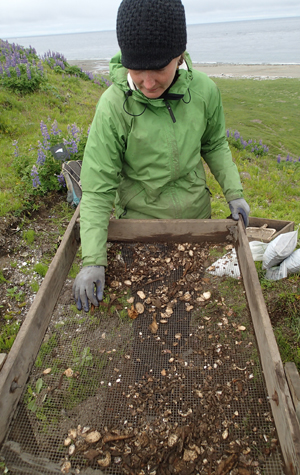Catherine West made the breathtaking ruggedness of the Gulf of Alaska her climate change workshop in part because of the feral cows.
That’s right. Wild cattle, the descendants of domestic bovines introduced by American ranchers in the 19th century, have devoured most of the vegetation and trampled archaeological sites on Chirikof Island in the Kodiak Archipelago. The US Fish and Wildlife Service asked West, a College of Arts & Sciences research assistant professor of archaeology, to study the archaeological record before the cows obliterate it for some clue to the island’s pristine state—including the climate.
To do that, West looks at what people ate. Bones and shells from the meat and fish that inhabitants lived on centuries and millennia ago have built up in garbage pits or on the ground. She tries to corroborate her data with climate-related information collected by other scientists who study things from glaciers’ advances and declines to vegetation changes. Bostonia spoke to West about her work.
Bostonia: What do ancient meat consumption and changes over time tell you about climate change?
West: They tell me that these people hunted whale, porpoise, everything you could imagine. One of the things that might affect what they choose to hunt is the climate. If the climate changes, fish that don’t want to be warmer or colder will swim away and recolonize somewhere else. The warmth or coolness of the ocean will affect, for instance, how well salmon spawn from year to year. If a certain food was not available, I won’t see it in the archaeological record; if it was available, I will see it.
What makes Chirikof Island such fertile ground to study ancient remains?
The far north is experiencing climate change more obviously and faster than other places in the world. Kodiak is actually a temperate place; it’s not as cold as farther north in Alaska, where they’re experiencing loss of sea ice and warm-weather birds, like robins, coming to roost where they’ve never been seen before. But the Gulf of Alaska economy relies on fishing and the natural environment. People in that region are very concerned about what will happen if the climate changes. Being in a place where the environment is so important helps me connect the past to the present in a more profound way than I could do in other places.

West sifts through bones and shells found in garbage pits for clues to the diet of ancient inhabitants.
People today seem concerned about climate change because human activities are driving it, but you are studying a time when climate change was natural.
I’m concerned with understanding how people and animals adapted to those changes in the past, and what we can learn about how to adapt in the future. What did people do in a small, subsistence community 3,000 years ago or 200 years ago to adapt to that change, and what might a small, subsistence community do today to learn from their ancestors to adapt their own approaches to fishing now in the face of massive climate change?
We always think of these small groups as vulnerable to changes in climate, but I think the people living in this region were extremely resilient. They lived in such a volatile environment—volcanoes, earthquakes, extreme winter storms, starvation periods—and yet they thrived. What can we learn about that resiliency and apply to our own adaptations?
Does your research leave you hopeful that we’ll be able to adapt?
It does. Some concepts are vague—how we might translate from a tiny group of hunter-gatherers to a huge industrial society like we live in today.
The reason I started this project with feral cattle is that this is tangible. I can see a very clear effect of human action on the landscape. I can look at what happened before that introduction, and inform a resource manager about how they might manage that landscape back to a healthy place.














































Related Stories
Trustees Adopt Broad Climate Change Strategy
Cutting energy demand and avoiding investment in coal, tar sands included
Studying Climate Change One Tree at a Time
BU researchers spend a summer in the woods
Climate Change and an “Overlooked” Nutrient: Silica
Warmer winters could have consequences in temperate forests and beyond
Post Your Comment